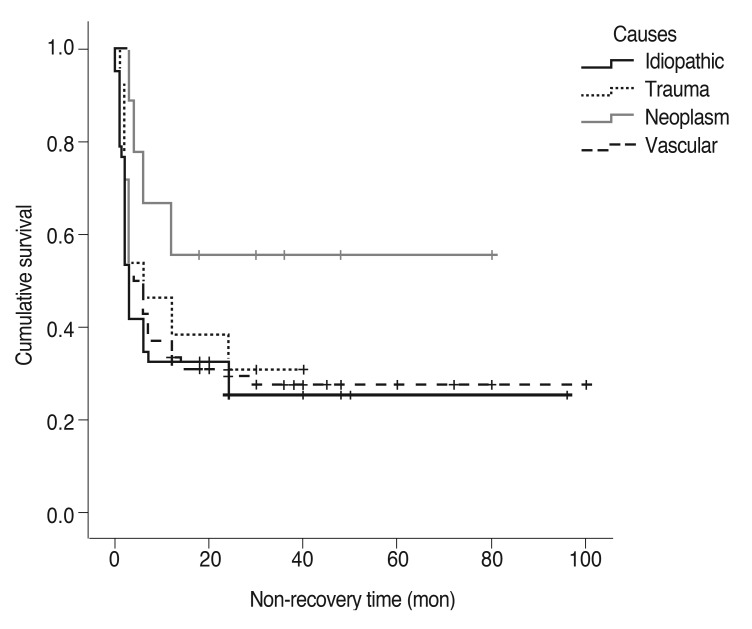Korean J Ophthalmol.
2018 Jun;32(3):221-227. 10.3341/kjo.2017.0051.
Clinical Course and Prognostic Factors of Acquired Third, Fourth, and Sixth Cranial Nerve Palsy in Korean Patients
- Affiliations
-
- 1Department of Ophthalmology, Kyung Hee University Medical Center, Kyung Hee University School of Medicine, Seoul, Korea. khjinmd@khu.ac.kr
- KMID: 2412801
- DOI: http://doi.org/10.3341/kjo.2017.0051
Abstract
- PURPOSE
This study aimed to evaluate the clinical course and prognostic factors of acquired third, fourth, and sixth cranial nerve (CN) palsy grouped according to etiology.
METHODS
This study involved a retrospective review of the medical records of 153 patients who were diagnosed with acquired paralytic strabismus from January 2004 to July 2015. Outcomes, recovery rates, and time to recovery were investigated according to the affected CN: CN3, CN4, and CN6 palsies. The patients were classified into four groups based on etiology: idiopathic, traumatic, neoplastic, and vascular.
RESULTS
The mean age of the patients was 59.8 ± 14.5 years and the mean follow-up period was 10.8 months. Out of the 153 patients, 63 (41.2%) had CN3 palsy, 35 (22.9%) had CN4 palsy, and 55 (35.9%) had CN6 palsy. The most common causes were vascular related (54.9%), followed by idiopathic (28.1%), trauma (8.5%), and neoplasm (5.88%). About 50% of the patients recovered within six months. Among the four etiologic groups, the idiopathic group showed the best prognosis because about 50% of the patients in this group recovered within three months. This was followed by the vascular, traumatic, and neoplastic groups. Cox proportional hazard analysis revealed a significant association between the baseline prism diopter and recovery rate.
CONCLUSIONS
The prognosis and natural history of paralytic strabismus vary depending on its cause. The vascular group had the best recovery rate and shortest recovery time, whereas the neoplastic group required the longest time to recover.
MeSH Terms
Figure
Reference
-
1. de Camargo GB, Hida WT, Goldchmit M, et al. Paralytic strabismus: review of 24 years at “Santa Casa de São Paulo”. Arq Bras Oftalmol. 2007; 70:585–587. PMID: 17906751.2. Mwanza JC, Ngweme GB, Kayembe DL. Ocular motor nerve palsy: a clinical and etiological study. Indian J Ophthalmol. 2006; 54:173–175. PMID: 16921214.
Article3. Richards BW, Jones FR Jr, Younge BR. Causes and prognosis in 4,278 cases of paralysis of the oculomotor, trochlear, and abducens cranial nerves. Am J Ophthalmol. 1992; 113:489–496. PMID: 1575221.
Article4. Patel SV, Holmes JM, Hodge DO, Burke JP. Diabetes and hypertension in isolated sixth nerve palsy: a population-based study. Ophthalmology. 2005; 112:760–763. PMID: 15878054.5. Sanders SK, Kawasaki A, Purvin VA. Long-term prognosis in patients with vasculopathic sixth nerve palsy. Am J Ophthalmol. 2002; 134:81–84. PMID: 12095812.6. Choung HK, Chang BL. Clinical features of ischemic ophthalmoplegia caused by diabetes mellitus or hypertension. J Korean Ophthalmol Soc. 2002; 43:131–135.7. Jacobson DM, McCanna TD, Layde PM. Risk factors for ischemic ocular motor nerve palsies. Arch Ophthalmol. 1994; 112:961–966. PMID: 8031277.
Article8. Rush JA, Younge BR. Paralysis of cranial nerves III, IV, and VI: cause and prognosis in 1,000 cases. Arch Ophthalmol. 1981; 99:76–79. PMID: 7458744.9. Patel SV, Mutyala S, Leske DA, et al. Incidence, associations, and evaluation of sixth nerve palsy using a population-based method. Ophthalmology. 2004; 111:369–375. PMID: 15019392.
Article10. Ho TH, Lin HS, Lin MC, Sheu SJ. Acquired paralytic strabismus in Southern Taiwan. J Chin Med Assoc. 2013; 76:340–343. PMID: 23608076.
Article11. Tiffin PA, MacEwen CJ, Craig EA, Clayton G. Acquired palsy of the oculomotor, trochlear and abducens nerves. Eye (Lond). 1996; 10(Pt 3):377–384. PMID: 8796166.
Article12. Lee WY, Kim JH, Shin H. A clinical study of paralytic strabismus. J Korean Ophthalmol Soc. 1993; 34:549–554.13. Park UC, Kim SJ, Yu YS. Clinical features and natural history of acquired third, fourth, and sixth cranial nerve palsy. J Korean Ophthalmol Soc. 2005; 46:1555–1562.
Article14. Hopf HC, Gutmann L. Diabetic 3rd nerve palsy: evidence for a mesencephalic lesion. Neurology. 1990; 40:1041–1045. PMID: 2356004.
Article15. Coello AF, Canals AG, Gonzalez JM, Martin JJ. Cranial nerve injury after minor head trauma. J Neurosurg. 2010; 113:547–555. PMID: 20635856.
Article16. Shin H, Park SE. A clinical study of acquired paralytic strabismus in a secondary hospital. J Korean Ophthalmol Soc. 2007; 48:311–314.17. Park KH, Chang BL. The etiology and clinical feature of the third, fourth, and sixth cranial nerve palsy. J Korean Ophthalmol Soc. 1997; 38:1432–1436.18. Asbury AK, Aldredge H, Hershberg R, Fisher CM. Oculomotor palsy in diabetes mellitus: a clinico-pathological study. Brain. 1970; 93:555–566. PMID: 5507015.
Article19. Hyun J, Kim SY. Clinical features and natural course of superior oblique palsy. J Korean Ophthalmol Soc. 2013; 54:627–631.
Article
- Full Text Links
- Actions
-
Cited
- CITED
-
- Close
- Share
- Similar articles
-
- The Etiology and Clinical Feature of the Third, Fourth, and Sixth Cranial Nerve Palsy
- Risk Factors and Prognosis of Isolated Ischemic 3rd, 4th, 6th Cranial Nerve Palsy
- Clinical Features and Natural History of the Acquired Third, Fourth, and Sixth Cranial Nerve Palsy
- A Clinical Study of Acquired Paralytic Strabismus in a Secondary Hospital
- Etiology of Isolated Third, Fourth, and Sixth Cranial Nerve Palsies with a Cancer History


